2008 Bloom Season
The following is the final summary of what happened in 2008. Also provided are "status reports" for different dates during the year for those who are interested in the progression of observations and commentary.
A significant regional-scale Alexandrium catenella bloom occurred within the Gulf of Maine in 2008 (see map). Toxicity was particularly high in eastern Maine but also extended south to Massachusetts Bay and parts of Cape Cod. An offshore bloom of the species was also detected on Georges Bank. It is noteworthy that this bloom was predicted several months in advance based on the abundance of A. catenella cysts in Gulf of Maine sediments (see press release).
2008 Status Reports
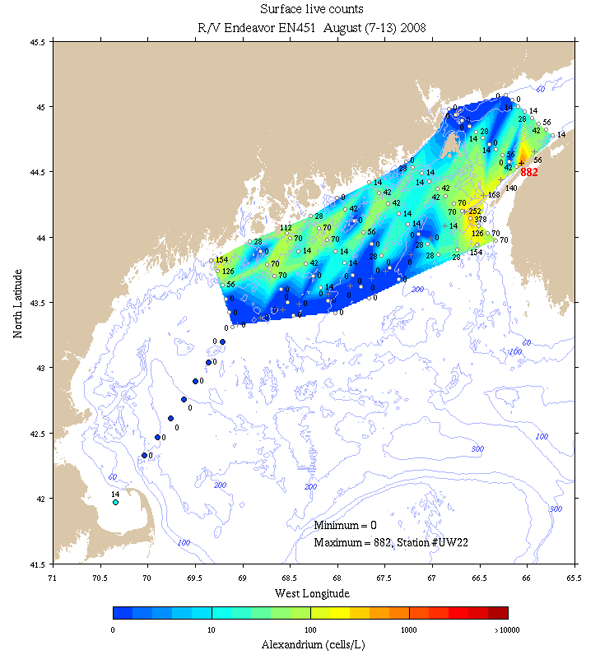
Alexandrium live counts, R/V Endeavor, August 7 - 12, 2008
(WHOI / D. Anderson and D. McGillicuddy laboratories)
Hello All,
Sampling operations on voyage 451 of R/V Endeavor came to a successful conclusion Tuesday evening. Live counts revealed generally low concentrations of Alexandrium (see attached). The peak concentration of 882 cells per liter was detected on an underway count just offshore of the Digby Peninsula. Otherwise concentrations in the two sections inside the Bay of Fundy itself were less than 100 cells per liter. A narrow tongue of ca. 100-400 cells per liter was present southwest of Digby, perhaps flowing “around the corner” from the Scotian shelf into the bay.
These findings are in stark contrast to those reported by Townsend et al. (2001), who documented cell concentrations of thousands of cells per liter at the mouth of the Bay of Fundy in August 1998.
EN451 cell counts offshore of Maine were generally low, ranging from zero at the offshore boundary of the survey up to ca. 150 cells per liter near the coast.
That’s all for now; we are in transit to Narragansett and expect to make port at 1400 Wednesday.
Best Wishes,
Dennis
On behalf of the science party for EN451
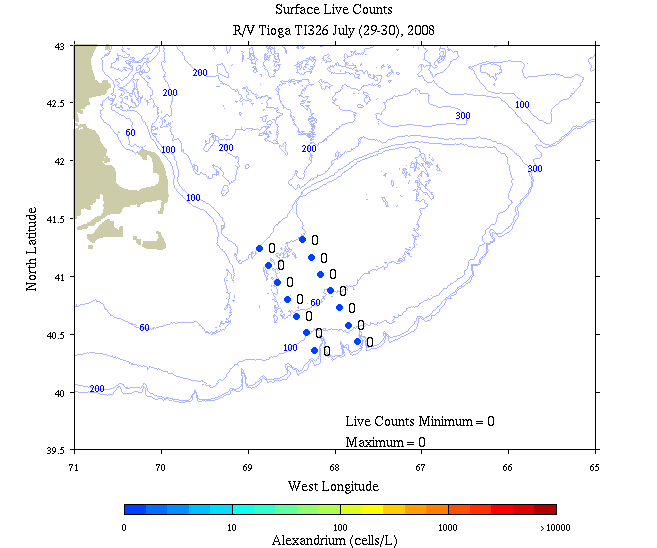
Alexandrium surface live counts. R/V Tioga, July 29-30, 2008
(D. Anderson & D. McGillicuddy laboratories))
The unexpected decline in the Alexandrium population on Georges Bank observed June 27 – July 3 on R/V Endeavor cruise EN448 suggested that bloom may be winding down. In order to ascertain whether or not that was the case, R/V Tioga sampled the two sections of Georges Bank where we have consistently found highest Alexandrium concentrations in our prior surveys. This achievement was made possible by superb scientific operations on the part of Bruce Keafer, Kerry Norton, Bibiana Crespo, and Keston Smith, together with the outstanding seamanship of Capt. Ken Houtler and crew Ian Hanley. As you will see in the map, Alexandrium is absent from those two sections, indicating the Georges Bank bloom is over (for now). Thus the GOMTOX objective of sampling the seasonal evolution of that bloom is complete. Therefore, our upcoming cruise EN451 (August 6-12) will focus on the Bay of Fundy and eastern Maine. We will keep you updated as those data become available.
Dennis McGillicuddy

Alexandrium live counts, R/V Endeavor, June 27 - July 3, 2008 (WHOI / D. Anderson & D. McGillicuddy laboratories)
Sampling operations on voyage #448 of R/V Endeavor are complete, and we will make port at ca. 1600 today.
Surface live counts (see map) show that the Alexandrium bloom on Georges Bank have decreased dramatically since the last cruise. The north flank and most of the crest were nearly devoid of cells. A modest tongue of cells (tens to less than 200 cells l-1) emanated from the western side of the northeast peak, extending down the southern flank. The outer edge of the tongue was interrupted by an intrusion of high-salinity slope water. Peak cell concentrations of 224 and 378 cells l-1 were found to the northwest of the slope water intrusion.
These findings are in stark contrast to the results from earlier cruises, during which large areas of the bank were covered by hundreds of cells l-1 in late April / early May (OC445) and thousands of cells l-1 in late May / early June (OC447). The dramatic decrease in Alexandrium abundance from OC447 to EN448 may be associated with a change in plankton community structure. A true-color satellite image provided by Andy Thomas prior to departure suggests the presence of a coccolithophore bloom on Georges Bank and in the adjacent slope waters. Indeed, surface waters had the characteristic “milky green” hue, especially on the southern flank. Microscopic examination of surface samples concentrated by centrifuge confirmed the presence of coccolithophores (Dave Townsend).
Thanks are due to the science party and ship’s crew for a successful voyage. We wish you all a happy and safe 4th of July weekend.
Dennis McGillicuddy, Chief Scientist
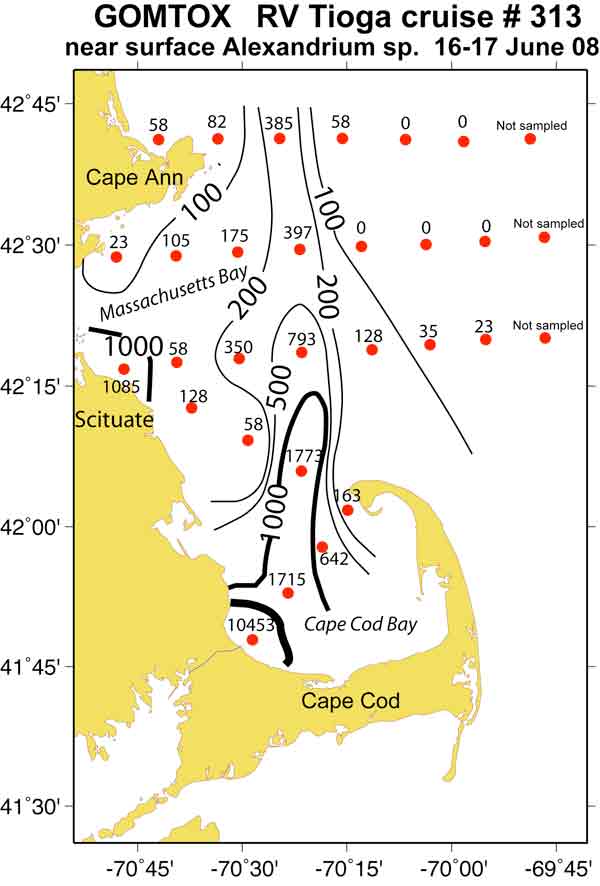
Alexandrium surface live counts. R/V Tioga, June 16-17, 2008
(WHOI / D. Anderson & D. McGillicuddy laboratories)
The R/V Tioga surveyed the waters of Massachusetts and Cape Cod Bays last week. The Alexandrium live counts indicated that the bloom is ongoing with the highest concentrations observed in Cape Cod Bay. Near the east entrance of the Cape Cod Canal, the maximum concentration was observed at >10,000 cells/L. Incoming surface populations were observed near Cape Ann at relatively low levels (100-300 cells/L). Another patch off of Boston/Scituate was observed at about 1000 cells/L - see map.
Note that most of the cells in the intense patch near the canal entrance were slightly larger, darker and more granular than typical vegetative cells suggesting that the population is now producing a significant number of planozygotes. On Friday June 20, we transited back through that area to redeploy a mooring on southern Stellwagen Bank. As we crossed the area, several samples were collected in Buzzard's Bay to determine if the population was transported through to the west side of the Canal. Less than 20 cells/L were observed at 3 stations in Buzzards Bay. Furthermore, low numbers (<50 cells/L) were also observed on the east side of the canal - the high population observed just offshore of the east entrance to the canal earlier in the week was not found there later in the week. Either that population was below the 1m sampling depth or had been transported out of that area or may have even produced cysts given the observation of planozygotes.
Note also that we cannot provide near real time Alexandrium data at depth, but as the bloom seasonally progresses, we often observe the maximum cell concentration deeper in the water column. At our mooring station on southern Stellwagen Bank, we counted samples at both the surface and 20m depth; the surface concentration was 23 cells/L, while the concentration at 20m was 233 cells/L. This observation indicates that the surface concentrations reported here may be underestimates of the population in the area at this time.
Thanks again to the science party (stalwart Kerry Norton and two summer students in the Anderson lab, Rob Arnold and Shayla Faizan) and the excellent crew of the R/V Tioga.
We're out on the R/V Endeavor sampling near Nantucket Shoals and on Georges Bank later this week and into early July, but plan to add days to the sampling schedule for one more survey in Mass Bay on the R/V Tioga when we return (now scheduled for July 8-10th).
Bruce Keafer, Chief Scientist
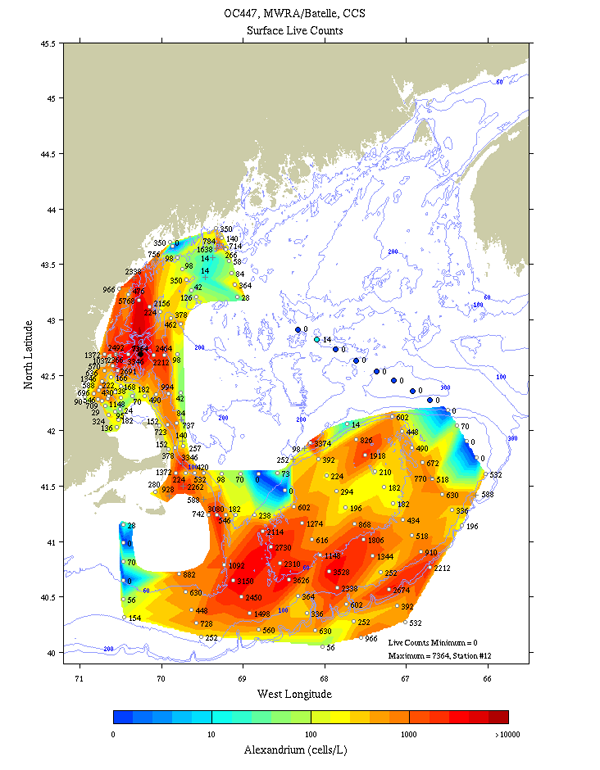
Alexandrium surface live counts. R/V Oceanus 447, Center for Coastal Studies, MWRA/Battelle, May 27 - June 4, 2008
(D. Anderson & D. McGillicuddy laboratories, Woods Hole Oceanographic Institution)
Upon completion of the western Gulf of Maine (GOM) survey, we turned our attention to Georges Bank and southern New England (see map).
Surface underway counts across the gulf in between the two regions yielded mostly zeros, as did most of the cross-bank section on the northeast peak of Georges Bank. The remainder of the bank was almost completely covered by cell concentrations ranging from a few hundreds to a few thousands of cells l-1. Concentrations on the central part of the crest were generally lower than the surrounding waters, with cell counts of ca. 200 cells l-1 or less. Highest concentrations were observed on the southern and southwestern parts of the bank, with the peak concentration reaching 3626 cells l-1. Surprisingly, cell concentrations in excess of 1000 cells l-1 extended all the way out to the shelf break in some cases. A set of six stations offshore of the 300m isobath were occupied in an attempt to delimit the southern extent of the bloom; even these showed cell counts of several hundred to nearly 1000 cells l-1.
The Georges Bank survey was integrated into the WGOM survey through additional stations east of Cape Cod occupied by the Center for Coastal Studies, in addition to two sections across the Great South Channel occupied by Oceanus. A tongue of several hundred cells per liter extends down the back side of Cape Cod, into the Great South Channel, and appears contiguous with the mass of thousands of cells l-1 on the southwestern part of Georges Bank.
Transects on the continental shelf of southern New England suggest the Georges Bank population is being swept westward by the prevailing flow. The Nantucket Shoals line was populated by several hundred to nearly 1000 cells l-1. Cell counts diminished considerably on the Martha's Vineyard line, with only the most offshore station exceeding the 100 cell l-1 mark.
We will make port in Woods Hole at ca. 0830 Wednesday. I'd like to sign off with a hearty thanks to the science party and ship's crew of OC447, all those involved in the collection and processing of cell counts in the Center for Coastal Studies transects and the MWRA/Battelle survey of Mass Bay. We also greatly appreciate the toxicity status reports provided by resource managers through the Northeast PSP listserver. That information certainly influenced our sampling plan, and is a good reminder of why we are all out here.
Dennis McGillicuddy, Chief Scientist
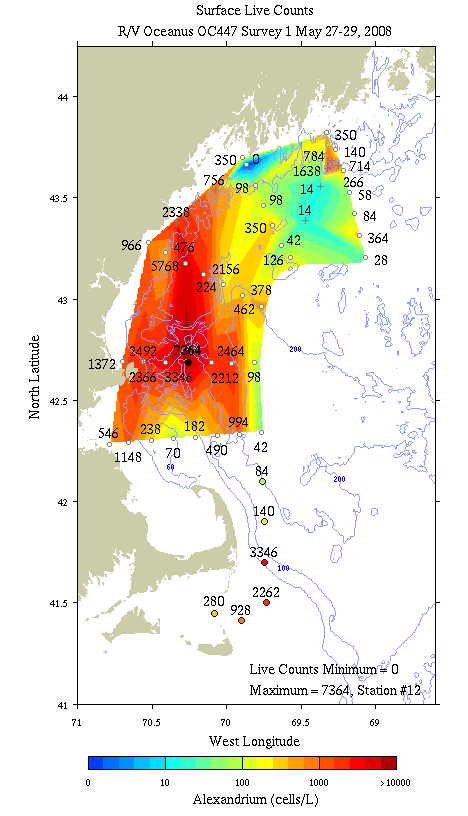
Alexandrium surface live counts (R/V Oceanus May 27-29, 2008. (WHOI / D. Anderson and D. McGillicuddy laboratories)
A map of surface live counts from Oceanus (OC447) is shown on the right. The Alexandrium bloom in the western Gulf of Maine is in full swing.
Underway counts during our exit from Nantucket Sound and northward along the back side of Cape Cod showed significant numbers of cells in the range of 1000-3000 cells per liter. Once our transit took us seaward of the 100m isobath east of Wellfleet, cell counts dropped precipitously to ca. 100 or less. We began CTD operations at the Boston line, where cell counts in the 500-1000 range were present in the inner two stations and also offshore near the end of the transect. All but the most offshore station of the Cape Ann transect had cell concentrations in excess of 1000 cells per liter, with peak concentrations exceeding 7000. Concentrations decreased overall in the Saco Bay line, although the peak reached nearly 6000 cells per liter. Underway counts between Saco Bay and Casco Bay ranged from 2300 to 800. Cell concentrations decreased dramatically on the Casco Bay line, peaking at 350 cells per liter. Underway counts from SW to NE in between the Casco Bay line and the Monhegan line were low until a near-shore tongue of cells was encountered with patchy concentrations ranging from 140 to 1600. Offshore waters in the Monhegan transect were generally below 100 except for a single station with 364 cells per liter.
Currently we are in transit to Georges Bank, and will report on those results as they become available.
Dennis McGillicuddy, Chief Scientist
As of this writing, the 2008 bloom of Alexandrium catenella is proceeding in a manner strikingly similar to that observed at the onset of the 2005 event. In 2005, for example, the first areas to become toxic were in western Maine and New Hampshire, during the first week of May. This year, during that same interval, those areas again became toxic and were closed for shellfish harvesting (see comparison maps). In 2005, the toxicity subsequently spread to the south (Massachusetts) and to eastern Maine in subsequent weeks. This has also occurred in 2008 with toxicity extending further to the east in Maine, as well as into northern Massachusetts and, most recently, to Boston's south shore as of May 20th.
We have conducted cruise operations to sample for Alexandrium cell abundance, and these observations are entirely consistent with the patterns of shellfish toxicity. During our first GOMTOX cruise in 2008, funded by the NOAA NCCOS program called ECOHAB with leverage from the NSF/NIEHS Centers for Oceans and Human Health, a large offshore bloom of Alexandrium catenella was documented, along with the beginnings of the 2008 coastal bloom of this organism in western Maine. The offshore toxicity is significant, as Georges Bank and Nantucket Shoals are important resources for surfclams, ocean quahogs, and sea scallops, all of which can be affected by PSP toxins. Note that the portion of the scallop eaten in U.S. markets (the adductor muscle) is not affected by PSP toxins.
Smaller-scale vessel surveys have subsequently demonstrated that A. catenella cells are in moderate abundance in the vicinity of Cape Ann Massachusetts, and have also entered Massachusetts and Cape Cod Bays due to the northeasterly winds that have been prominent over the last several weeks. This distribution is again strikingly similar to Alexandrium abundances mapped out at the onset of the 2005 bloom at the same point in time. Shortly after this recent cruise on May 15-16, 2008, shellfish beds from Hull to Marshfield, Massachusetts were closed, consistent with the observed cell distributions.
Looking ahead, the winds over the next week or two will be critical in determining the extent and magnitude of the toxicity in nearshore shellfish. Sustained winds out of the southwest may stall the southward progression of the bloom and reduce its magnitude, whereas strong northeasterly winds may create high toxicity and spread the problem further, much as occurred in 2005 with a major northeaster on May 23. Furthermore, our experience also tells us that the progression of toxicity in Maine is generally from west to east, and as the 2008 bloom season progresses, we expect that the coast of Maine will have more closures in eastern waters over the next month or two.
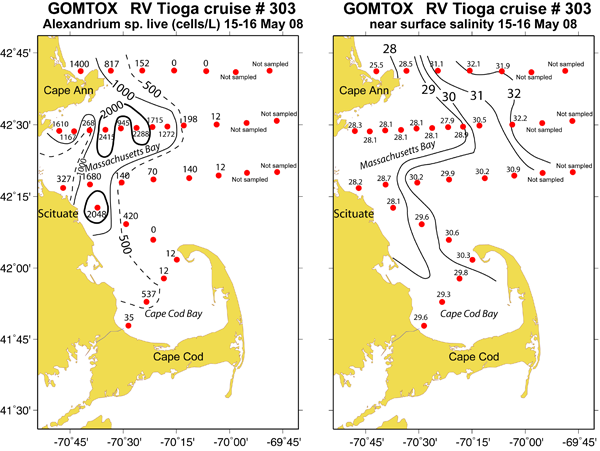
Alexandrium surface live counts (left panel), R/V Tioga May 15-16, 2008, and near surface salinity (right panel)
(D. Anderson laboratory, Woods Hole Oceanographic Institution)
As part of the GOMTOX program, a two-day Alexandrium survey in Mass Bay was completed late this week after strong winds and rough seas from the recent nor’easter subsided.
Live counts from surface Niskin samples indicated that the Alexandrium sp. population has now penetrated into Massachusetts and Cape Cod Bays. Alexandrium sp. concentrations were observed at 1400 cells/L near Annisquam (north of Cape Ann) in very low salinity waters (25.5 PSU and 10.8 C). About 5-10 nm to the south and east of Cape Ann, >2000 cells/L were observed within low salinity waters entering the Bays (approximately 28.1 PSU and 10-11 C). Concentrations of approximately 1000-2000 cells/L extended further into Mass Bay offshore of Boston and along the south shore near Scituate, MA. The highest concentrations observed in Cape Cod Bay were approximately 500 cells/L located about 8nm northeast of the east entrance to the Cape Cod Canal. At this time in mid-May, these concentrations are strikingly similar to those reported in Mass Bay during the beginning of the 2005 outbreak.
A map posting the results from the live count observations and near surface salinity is posted on the right.
Thanks to the Captain and crew of the R/V Tioga (Ken and Ian) and especially to the other members of the science party (Kerry Norton, Stacey Lee, Bibiana Crespo), who worked very diligently to help collect the samples and data. Without their hard work and a little slot in the weather, this critical mission would not have been possible.
Still rocking,
Bruce Keafer
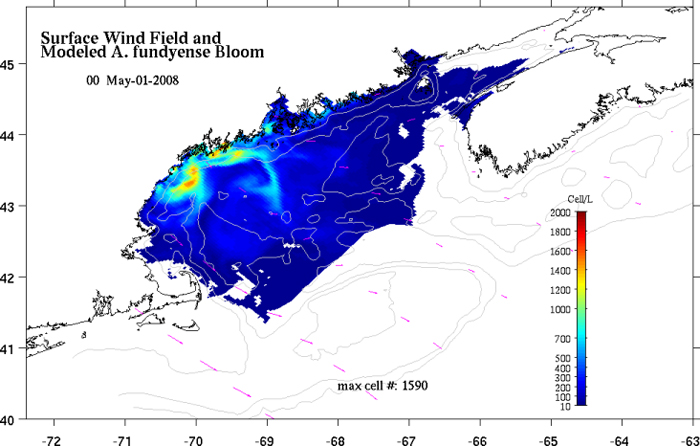
A near-real-time quasi-operational forecast of A. catenella cells in the Gulf of Maine.
(R. He, NCSU)
Timely completion of the Georges Bank survey conducted on voyage #445 of R/V Oceanus allowed for some sampling in the western Gulf of Maine. The near-real-time quasi-operational A. catenella forecast was received at sea, indicating that the strong southeast winds early in the week reduced cell concentrations (presumably by vertical mixing) and arrested the along-shore movement of the bloom (see map, upper right). It was therefore decided to begin the WGOM sampling with the Casco Bay transect, just upstream of where the model indicates the highest cell concentrations reside.
Live counts from the western Gulf of Maine survey indicate significant cell concentrations in the Casco Bay and Saco Bay transects (see map, lower right). In the Casco Bay transect, the peak concentration of 112 cells l-1 was observed just offshore of a very strong river plume signature that extended 30 km offshore. Cell concentrations were considerably higher in the Saco Bay transect, where the peak concentration of 882 cells l-1 was observed. Alexandrium concentrations decreased to below 100 cells l-1 in the Cape Ann transect, and below 30 cells l-1 in the Boston transect. The volume of fresh water is very large in the Boston transect, with the outcrop of the 32 ppt isohaline nearly 70km offshore.
These findings are in stark contrast with those from 2007, where surface waters of the western Gulf of Maine were virtually devoid of Alexandrium cells in mid-to-late May (later in the bloom season). Live counts from EN437 (May 17-31 2007) were almost all zeros, with Alexandrium detected at only a few isolated stations. The peak concentration of 84 cells l-1 was observed at the innermost station of the Saco Bay transect.
Surface observations in the western Gulf of Maine during the late April / early May time period during the ECOHAB-GOM era indicate peak cell concentrations ranging from zero to approximately 200 cells l-1. In comparing the live counts from the present cruise with those published observations, one must bear in mind the methodological differences: the former are difficult to distinguish A. catenella from other species that are morphologically similar, whereas the latter are more specific. Nevertheless, the initial results of OC445 indicate peak surface cell concentrations in the western Gulf that are higher than prior observations at this very early stage of the bloom season. Our findings are thus not inconsistent with the hypothesis that the 2008 bloom will be anomalously large.
Qualitatively, the observations agree with the model predictions for May 1 insofar as (1) cells are present from Casco Bay down to Cape Ann; (2) peak concentrations occur offshore of Saco Bay; (3) cells are virtually absent from Massachusetts Bay. Modeled concentrations are somewhat higher than observed, but the patterns are similar.
I'd like to close with highest compliments to the science party and crew of the R/V Oceanus. Thanks to their superb efforts, a very large area of ocean was sampled in only eight days. It has been a privilege to work with such a talented and dedicated group of individuals.
Dennis McGillicuddy
Chief Scientist
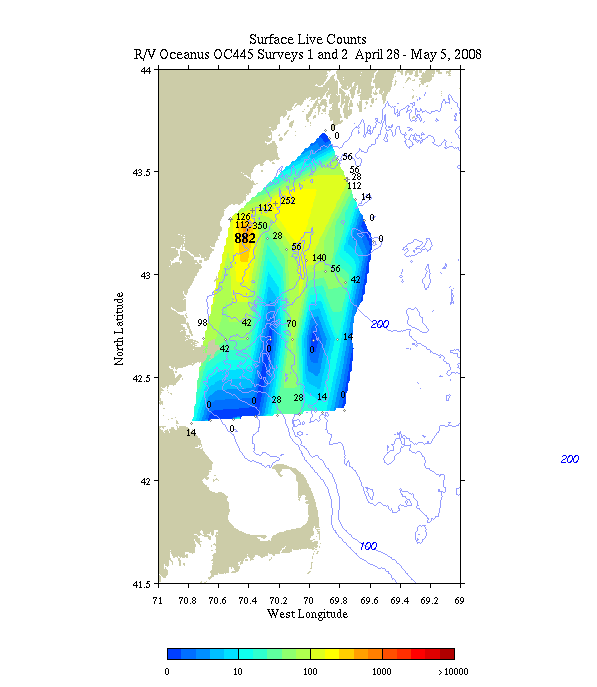
Alexandrium surface live counts. R/V Oceanus April 28 - May 5, 2008
((D. Anderson & D. McGillicuddy laboratories, Woods Hole Oceanographic Institution))
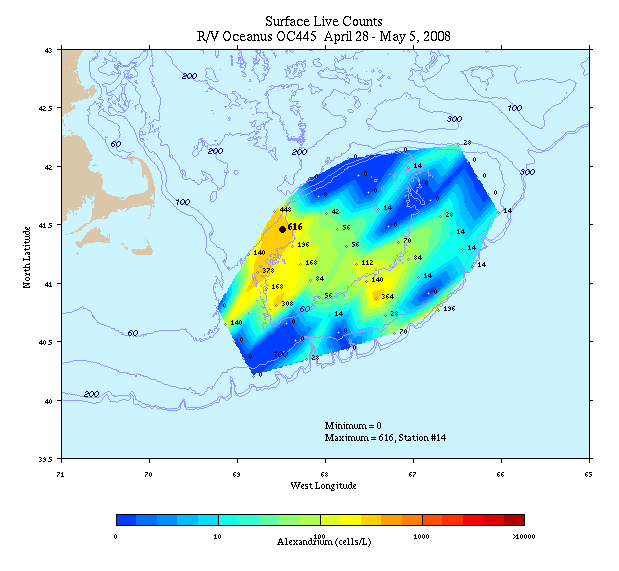
Alexandrium surface live counts. R/V Oceanus April 28 - May 5, 2008 (D. Anderson & D. McGillicuddy laboratories, Woods Hole Oceanographic Institution)
Our Georges Bank survey is complete (see map on right). Surface live counts indicate cell concentrations ranging from zero to several hundred cells per liter, with highest concentrations on the northwest part of the bank. Tens to hundreds of cells per liter extend through the western half of the crest to the southern flank. Two distinct water mass anomalies are present on the southern flank: a warm salty intrusion to the west, and a cold fresh tongue to the east, which appears to have originated from a crossover of Scotian Shelf water visible in satellite imagery. Both of these water mass anomalies are nearly devoid of cells, thus these water mass anomalies may be contributing to the relatively low cell concentrations on that part of the bank.
We are steaming to the WGOM now, and expect to complete transects at Casco Bay, Saco Bay, Cape Ann, and Boston before it is time to head for the barn. ETA in WH is between 0800 and 1000 Monday.
Dennis McGillicuddy
Chief Scientist
